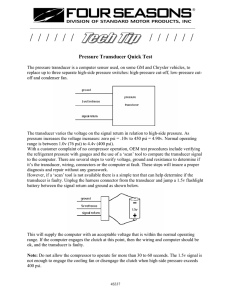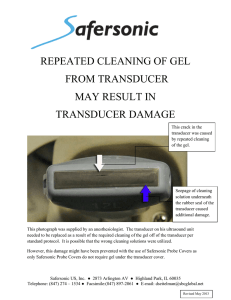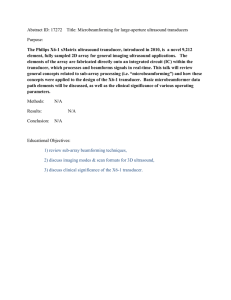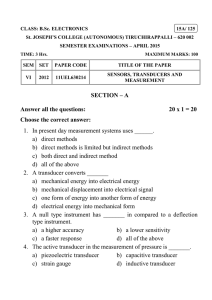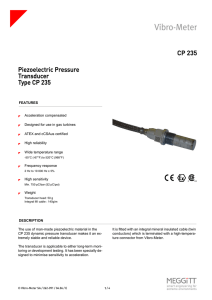WPS600 Hydraulic Pressure Transducer User`s Guide
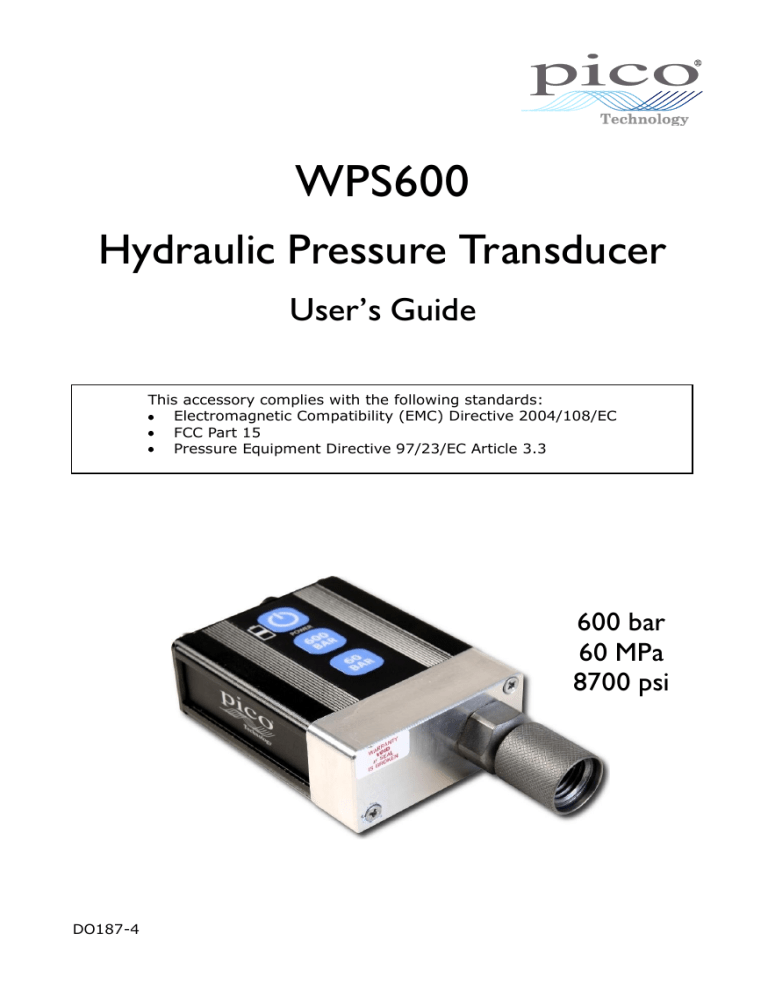
WPS600
Hydraulic Pressure Transducer
User’s Guide
This accessory complies with the following standards:
Electromagnetic Compatibility (EMC) Directive 2004/108/EC
FCC Part 15
Pressure Equipment Directive 97/23/EC Article 3.3
600 bar
60 MPa
8700 psi
DO187-4
Pico Technology WPS600 User’s Guide
1.
Safety
Symbols appearing in this manual:
WARNING statements identify conditions or practices that could result in injury or death.
WARNING
CAUTION
CAUTION statements identify conditions or practices that could result in damage to this product or other property.
Symbols appearing on the product:
Safety notices
Danger of personal injury or property damage. Refer to manual for details.
WARNING
Please review the following safety precautions to avoid injury and prevent damage to this transducer or any equipment that is connected to it.
HAZARDS OF HYDRAULIC SYSTEMS
Hydraulic systems contain several hazards:
Ejection of hot oil, which can cause skin burns
Pinhole leaks, which can inject oil through the skin, causing serious injury including loss of fingers and limbs
Unsecured high-pressure hoses, which can move at high speed and with large forces, causing injuries
Unsecured hydraulic machinery, which can move without warning, causing injury
DO
connect safely
This transducer must only be connected using pressure hoses and connectors designed for high-pressure hydraulic testing. No responsibility is accepted for damage or injury caused by the use of unsuitable pressure hoses or connectors.
DO
follow the equipment manufacturer’s safety instructions
Read the equipment manufacturer’s service instructions before starting work.
DO
wear appropriate personal protective equipment
Wear appropriate personal protective equipment (PPE), including safety glasses, when working with pressurized fluids.
DO187-4
WPS600 User’s Guide Pico Technology
DO NOT
use if you are not trained to work with hydraulic systems
Use of this transducer by unqualified persons may result in equipment damage or serious personal injury.
DO NOT
exceed maximum working pressure
To avoid injury, do not use the transducer with pressures above 600 bar.
DO NOT
exceed maximum temperature
The lithium polymer (LiPo) battery inside the transducer can be damaged by excessive heating. Do not store or operate the unit at temperatures above 60 °C
(140 °F).
DO NOT
operate without covers
To avoid equipment damage and personal injury, do not operate this transducer with the covers removed.
DO NOT
operate in wet or damp conditions
To avoid incorrect readings and possible equipment damage, do not operate this transducer in wet or damp conditions or submerge it in liquid. The transducer is splash-resistant but not immersion-proof.
DO NOT
operate in an explosive atmosphere
To avoid personal injury and fire hazard, do not operate this transducer in an explosive atmosphere.
DO NOT
operate the transducer if damaged
If you suspect that the transducer is damaged, have it inspected by qualified service personnel. Do not attempt to dismantle or repair it yourself.
DO NOT
use with damaged or modified pressure hoses
Use only pressure hoses that have been pressure-tested. Do not use them if they have been disassembled, modified or damaged.
DO NOT
use in long-term or permanent installations
The WPS600 is intended for immediate diagnostic purposes only. It should not, for example, be connected to a vehicle as a monitoring system.
4 DO187-4
Pico Technology WPS600 User’s Guide
2.
Introduction to the WPS600
The WPS600 diagnostic pressure transducer allows quick and accurate pressure analysis of hydraulic systems.
It offers these features: high resolution and accuracy zero adjustment two pressure ranges: o 600 bar / 60 MPa / 8700 psi o 60 bar / 6 MPa / 870 psi
Compatible fluid types
The WPS600 is designed for use with hydraulic fluids. Do not use with any other type of liquid or gas.
DO187-4 5
WPS600 User’s Guide Pico Technology
3.
The parts of your WPS600 pressure transducer
Signal output to oscilloscope
Front-panel controls
USB charging port
Signal output
Inlet port
Use the BNC-to-BNC cable supplied to connect this to your oscilloscope.
CAUTION
This connector is made of plastic to ensure electrical safety. It could be damaged by a strong impact.
Inlet port
Front-panel controls See Section 4.
USB charging port For battery recharging only (no data connection). Connect to any USB port on a computer or wall charger.
Connect the pressure hose here.
Re-ordering codes
If you need to re-order spare parts, please use the part numbers listed below.
WPS600 pressure transducer kit (PP833)
Part No Qty Description
TA092 1 WPS600 pressure transducer
TA081
MI030
DO187
PA041
1
1
1
1
USB to mini-USB charging cable 2 m
BNC to BNC cable 1 m
WPS600 User’s Guide
Carrying case
6 DO187-4
Pico Technology
4.
Front-panel controls
WPS600 User’s Guide
Charging indicator
Lights up when battery is charging.
Low battery indicator
Lights up when power is on but battery is low.
Range indicator
Show if the range is selected.
Power button
Press once to switch on. Press once again to switch off. Keep the unit switched off when not in use to conserve battery power.
Battery fault indicator
Stays lit if there is a problem with the battery.
Range button
Press to select the indicated range.
Press both buttons to calibrate the transducer.
DO187-4 7
WPS600 User’s Guide Pico Technology
5.
Preparation for use
Before first use
Remove all packaging.
Charge the internal battery. For instructions, see Section 7: “Maintenance”.
Zeroing the transducer
The WPS600 has a zeroing function to ensure its long-term accuracy. The transducer should be zeroed before first use, and can be zeroed again if the unit starts to show an error in the zero-pressure reading.
Begin with the transducer switched off.
If the transducer is connected to a pressurized system, make sure that the system is switched off and the pressure has been safely released.
Disconnect any items that are connected to the transducer’s inlet port.
Switch the transducer on and check that one of the range LEDs is lit.
Press both the “60 BAR” and “600 BAR” buttons at the same time, then release them. Both range LEDs will flash for a few seconds, and then the “600 BAR” LED will remain continuously lit.
The transducer is now zeroed.
8 DO187-4
Pico Technology WPS600 User’s Guide
6.
Using the WPS600
Preparing the transducer
Ensure that the transducer’s internal battery is charged.
Unplug the charging cable from the transducer.
Switch the transducer on.
The “600 BAR” LED will light up to show that the unit is ready.
Measuring pressure
WARNING
ALWAYS safely depressurize the system under test before connecting the transducer. DO NOT system that is already pressurized.
connect the transducer to a
WARNING
ALWAYS check that the pressure hose is securely fastened to the transducer BEFORE pressurizing the system. ALWAYS check for leaks when connecting the unit and NEVER leave it connected to a vehicle unattended.
Connect the transducer to the hydraulic system, either directly or through a suitable high-pressure hose.
WARNING
Use ONLY pressure hoses specifically designed for high-pressure testing. Pico Technology cannot accept responsibility for damage or injury caused by the use of unsuitable pressure hoses or adaptors.
Bleed any air out of the measurement chamber.
Use the BNC cable supplied to connect the output of the transducer to the input channel of the oscilloscope.
Switch on the computer and run the PicoScope software.
In the PicoScope software, select the pressure sensor in the drop-down menu and then the appropriate pressure test.
If necessary, press one of the Range buttons on the transducer to select the desired measuring range.
Start the test using the appropriate procedure directed by the manufacturer of the machine being tested.
A waveform showing the pressure of the system will appear on the PicoScope display.
Releasing the pressure in the measurement chamber
After a measurement, some pressurized fluid may remain in the measurement chamber. When disconnecting the pressure hose from the transducer, hold both items over a suitable container to catch the fluid expelled.
WARNING
DO NOT disconnect the transducer or the high-pressure hose from a pressurized system.
DO187-4 9
WPS600 User’s Guide Pico Technology
7.
Maintenance
Cleaning the housing
Clean the transducer’s housing by wiping it with a cloth moistened with clean water or water-based detergent. Allow the housing to dry before use.
Do not use fuel or any other solvent
Do not use abrasive cleaning agents
Do not submerge the unit in any liquid
Do not dismantle the unit
Do not use the unit until it is perfectly dry
Recharging the internal battery
To charge using a computer, switch on the computer and allow it to boot.
Disable any power-saving modes to ensure that the computer does not switch off before recharging is complete. Connect the transducer to the USB port of the computer using the USB charging cable provided.
To charge using a USB wall charger, connect the transducer to the charger using the USB charging cable provided.
Leave the transducer to charge for 5 hours.
Unplug the USB cable from the transducer before use. Leaving the cable plugged in may affect measurement accuracy.
The battery inside the WPS600 is designed to give a long service life and is not user-replaceable.
Repairs
If the unit is damaged or stops working, or the battery is not charging or holding charge, return it to Pico Technology or an authorized Pico distributor for repair. Do not attempt to dismantle or repair the unit.
Disposal
The WPS600 contains a lithium polymer (LiPo) battery. If the battery has reached the end of its life, you may return the unit for repair. When the transducer reaches the end of its life, take the entire unit to a battery recycling facility for safe disposal.
WARNING
YOU MUST observe the instructions below. Incorrect disposal of the battery could cause a fire or an explosion.
Do not open the unit to remove the battery
Do not crush or shred the unit
Do not dispose of in fire
10 DO187-4
Pico Technology WPS600 User’s Guide
8.
Specifications
Inlet
Pressure ranges 0 to 600 bar
0 to 60 MPa
0 to 8700 psi
0 to 60 bar
0 to 6 MPa
0 to 870 psi
M16 hydraulic test port Connector
Output
Scaling
Offset (typical)
Connector
Performance
Accuracy
Response time (10% to 90%)
Power supply
Type
Charging current
1 V / 100 bar
1 V / 1450 psi
1 V / 10 MPa
1 V / 10 bar
1 V / 145 psi
1 V / 1 MPa
Manual zeroing
BNC female, fits cable MI030
1% of scale
100 µs
Charging connector
Ambient operating temperature
Ambient storage temperature
Environmental protection
Weight
Dimensions
Built-in LiPo battery, not user-serviceable
500 mA (max.) at 4.75 V to 5.25 V from USB charger cable
USB mini, fits cable TA081
60 °C (140 °F) max.
60 °C (140 °F) max.
Splash-resistant against water, gasoline, diesel and hydraulic fluids. Not immersion-proof.
332 g (11.7 oz)
132 x 64 x 31 mm (5.2 x 2.5 x 1.2 in)
9.
Conversion factors
The SI unit of pressure and vacuum is the pascal, symbol Pa. This is related to psi
(pounds per square inch) and bar as follows:
1 bar = 100,000 Pa
1 psi = 6,894.757 Pa
10.
Technical support
For assistance with operating this device, please contact Pico Technology at www.picotech.com.
DO187-4 11
WPS600 User’s Guide
UK headquarters:
Pico Technology
James House
Colmworth Business Park
St. Neots
PE19 8YP
United Kingdom
USA headquarters:
Pico Technology
320 N Glenwood Blvd
Tyler
Texas 75702
United States
Pico Technology
This device complies with part 15 of the FCC Rules. Operation is subject to the following two conditions: (1) This device may not cause harmful interference, and (2) this device must accept any interference received, including interference that may cause undesired operation.
Manufactured in the United States
12
Copyright © 2011–2014 Pico Technology Ltd.
Pico Technology is a registered trademark of Pico Technology Ltd.
www.picotech.com
DO187-4
